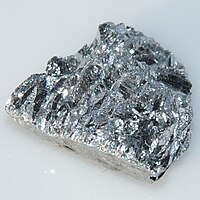
Photo from wikipedia
Molybdenum sulfides are considered a promising and inexpensive alternative to platinum as a catalyst for the hydrogen evolution reaction. In this study, we perform collision-induced dissociation experiments in the gas… Click to show full abstract
Molybdenum sulfides are considered a promising and inexpensive alternative to platinum as a catalyst for the hydrogen evolution reaction. In this study, we perform collision-induced dissociation experiments in the gas phase with the halogenated molybdenum sulfides [Mo3S7Cl6]2–, [Mo3S7Br6]2–, and [Mo3S7I6]2–. We show that the first fragmentation step for all three dianions is charge separation via loss of a halide ion. As a second step, further halogen loss competes with the dissociation of a disulfur molecule, whereas the former becomes energetically more favorable and the latter becomes less favorable from chlorine via bromine to iodine. We show that the leaving S2 group is composed of sulfur atoms from two bridging groups. These decomposition pathways differ drastically from the pure [Mo3S13]2– clusters. The obtained insight into preferred dissociation pathways of molybdenum sulfides illustrate possible reaction pathways during the activation of these substances in a catalytic environment.
Journal Title: Journal of the American Society for Mass Spectrometry
Year Published: 2022
Link to full text (if available)
Share on Social Media: Sign Up to like & get
recommendations!